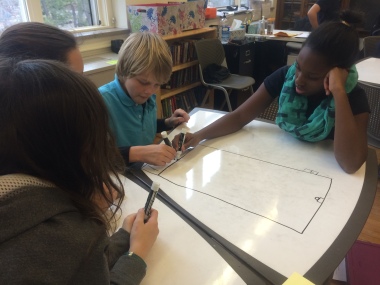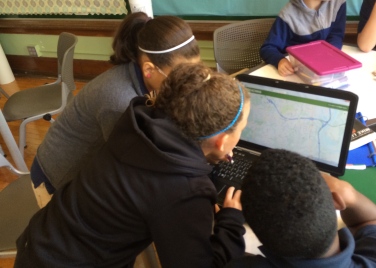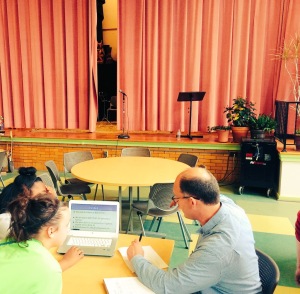If you’re like me, you have grown tired of seeing the same scenario playing out over and over again in your  math class. A student who is obviously struggling to grasp a new concept blurts out the question: “why do we have to learn this anyway?.” This question is usually immediately followed by the statement: “this is stupid.” The student then slouches over puts their head on the desk and you are left to attend to a situation in which you are struggling to reactivate the learner to try to complete the problem. After some pleading and motivating talk, the student reluctantly re-engage themselves in the task only to meet another difficulty a few minutes later and the scenario is played out again.
math class. A student who is obviously struggling to grasp a new concept blurts out the question: “why do we have to learn this anyway?.” This question is usually immediately followed by the statement: “this is stupid.” The student then slouches over puts their head on the desk and you are left to attend to a situation in which you are struggling to reactivate the learner to try to complete the problem. After some pleading and motivating talk, the student reluctantly re-engage themselves in the task only to meet another difficulty a few minutes later and the scenario is played out again.
About a year ago, I took a serious look at the big picture realizing that something just wasn’t working. As the content got more challenging, the same scene was being played out with increasing frequency. Throughout middle school, fewer students were identifying math class as their favorite subject. The fact that students didn’t love math class as much as they used really bothered me.
What was causing this trend to play out throughout the middle school years? I was teaching the class following the Connected Mathematics curriculum, which is written almost entirely in the context of ‘real-world’ problems. It always vexed me that students were still continually asking why they would need to know how to do any of the problems when the textbook provided good examples of ‘real world’ contexts. The best way to seek answers about students learning and the student mind is by asking the students themselves.
Middle schoolers seemingly have very little problem speaking their minds and telling you like it is even at the risk of hurting your feelings. I began asking my 8th graders during class discussions why they were unable to see a connection between the text and reality. The discussions always led to the same place- students wanted math that was more closely identifiable with their lived realities.
They were begging for content that was a direct extension of their passions and interests. I knew that I needed to address this problem. The only way that I could see a way to solving this problem was to throw out the Connected Mathematics curriculum and start over. As with any teacher, I would need to have a strong justification for what was a pretty risky move on my part.
Let’s take a look at the most compelling reasons for designing a curriculum that creates more authenticity in math class.
Increasing Engagement in Math Class
The most obvious justification for the switch to a more authentic approach to math is to increase student engagement in class. However, this justification is the most vague and the most open to questions about how you can actually determine if students are more actively engaged in the subject. I will do more to address how my colleagues and I determined the actual increase in student engagement that took place throughout the year in future blog posts. For now, I will focus on the question: How does authenticity in math increase student engagement? 
In each of the units this year, created what we termed the need to know. That is in each of the units, we determined an over-arching problem or question that put the students into a context that would drive student learning. Literature classes do well by allowing student to engage in texts that are relatable, why can’t math follow suit and engage students in contexts or problems that are real to our students? The context or problem could be something that the students didn’t know about but would be interested in as in the case of our Geocaching and Car Design units, or something that direct relationship to their lived experiences as in the case of our Gym Design unit.
In all of the units, there was one commonality: the topic provided a high level of student interest that drove them to want to do the difficult math that helped them to reach the best possible outcome. We ran our class as a forum in which we determine what we would need to know in order to solve the problem or answer the question. The students came up with the math content that they would need and as the experts, we facilitated the learning of the math concepts through the use of a variety of models that met the students where they are.
Allowing students to be the drivers of their own learning, changed learning math from something that was being done to them to something that they were doing. Although we were teaching the same content that would have been taught otherwise, we had students coming to the table of their own learning with a drive and a reason that they needed to know the math. This came with learners who were looking for avenues in which they could extend their learning to the next level while asking their own questions, coming to their own problems, and seeking out avenues that they could use math to answer the questions and solve the problems.
Decreasing the Achievement Gap
My classroom is no different than than the ones seen across the country. The same spectrum of needs is  exhibited in the space. The spectrum of learners generally shows up something like this:
exhibited in the space. The spectrum of learners generally shows up something like this:
- Learners who need to be pushed to extend their learning
- Learners who do well no matter how the content is being presented
- Learners who engage only when they see value and relevance
This is a very crude list of the different types of learners that can be exhibited in the classroom, but it ultimately gets at my point. The traditional curriculum works for those students who are the middle. This brought me to the question: if pretty much anything will engage students in the middle, why don’t we design a curriculum that focuses on engaging the students on the edge? I saw an increasing gap between those learners at the top and the bottom while the middle seemingly remained stagnant. One of the things that I have found myself pushing for is the need for eliminating tracking at the middle school level. I will cover this in future posts. For now, let’s get back to the crux of the issue.
Ultimately, we cannot expect to increase achievement if we have not first brought students to the table of their own learning. If we want students to do better, we need to increase their drive for learning. This starts by engaging the students in topics that are close to their lived realities. Once students have opened themselves to learning, we can stand to see vast improvements in achievement as evidenced by both formal and informal means. Thusly, we see a decrease in the achievement gap and the increase of achievement for all learners.
We all know that this issue is not as simple as what I have made it sound in this post. I would argue that if we continue to see this rising achievement gap, why shouldn’t we try something different?
Increasing Growth Mindset
 How many times have you heard a student say: “I can’t do this, it’s too hard?” I know that I have heard this one too many times throughout my teaching experience and I am certain that I will hear it many more times during my career.
How many times have you heard a student say: “I can’t do this, it’s too hard?” I know that I have heard this one too many times throughout my teaching experience and I am certain that I will hear it many more times during my career.
One of our goals as educators should be to decrease the frequency of the times that we hear this uttered in our classroom. So much of what we deal with as math educators is having students believe that if they work hard enough they can solve even the most difficult problems. We are trying to develop problem-solvers, right? If we have established a reason for students to solve problems and we can engage them in the problem solving process, there is an increasing reason for the students to want to solve the problems and to not give up on solving them until they do.
Once we had the drive for students to pay attention to their problem solving, we incorporated the major tenets of the growth mindset and continued to remind the students of the fact that they can solve the problem if they work at it and use the appropriate resources. We also took the idea of meeting students where they are at and scaffolding concepts for all learners. The final two things are not any different than what is attempted in every classroom. The one major difference is the fact that we need to give all of our students a reason to stick with a problem and really want to solve it. One of the ways that this can be done is through engaging learners in content that is directly relatable to their lives or interests.
This same model of using authentic contexts provides a problem that doesn’t get solved in a few minutes. It’s a problem that isn’t solved for week or months. Developing patient problem solvers allows student learners to realize that it is ok to set a problem aside for a while and come back to it. If we want to increase student ability to persevere in problem solving, we need to move away from the idea of instant gratification to a model of delayed gratification.
Final Thoughts
There are a lot of reasons to continue to hang on to the same way that we have taught math in the past. However, there are some really compelling reasons to try something different by moving to a model that  provides more authenticity in math class. I am not advocating for people to completely abandon the tried and true principles that have worked to teach math. There are a lot of great teaching methodologies that work for our learners if we can first engage them and bring them to the table of their own learning. We continue to march the same course of math teaching while arriving at the same conclusions: students are less engaged in math, the achievement gap is increasing, and students are giving up on tough problems. We need to step out of the box and change try new things so that we can start arriving at different conclusions about Math Education in this country. What can we stand to lose if we intertwine these same principles into a context that is relatable to our students’ lived experiences?
provides more authenticity in math class. I am not advocating for people to completely abandon the tried and true principles that have worked to teach math. There are a lot of great teaching methodologies that work for our learners if we can first engage them and bring them to the table of their own learning. We continue to march the same course of math teaching while arriving at the same conclusions: students are less engaged in math, the achievement gap is increasing, and students are giving up on tough problems. We need to step out of the box and change try new things so that we can start arriving at different conclusions about Math Education in this country. What can we stand to lose if we intertwine these same principles into a context that is relatable to our students’ lived experiences?
Tell me what you think.
Comment or Follow me on Twitter:
Follow @IntoOutside
I’m so torn on this issue. I always naturally gravitate toward project-based learning, or experiential learning, or authentic tasks, etc. etc., and away from “practice” (imitation) of a demonstrated technique.
BUT. I look at that l-o-n-g list of Common Core content standards my kids will be expected to know and build upon, and I feel like I need to provide a lot of structure to cram some of those things into the school year. What overarching student-driven sixth grade project would include nets of 3-D shapes, long division by hand of decimal numbers, and coordinate planes?
Having said that, I’m trying to revamp my curriculum more along the lines you suggest. I’ve gotten pretty darn close with the 6th grade statistics standards (someday I will blog about this). Next, I’ll be gunning for rates and ratios. I’ve considered having them analyze whether the school should buy Chromebooks for all students and how that would affect photocopying costs, etc., but it got too complicated this year. Maybe next year!
But for now, we’ll struggle along with Connected Math (2nd edition) for most of the other units. My main beef with it is actually the formatting and overstuffing of lessons, so sometimes I have success with grabbing their problems/setup and streamlining them. That gets around those awkward issues like “What was your thinking on problem 4.2 A.1.b.iii?”
LikeLiked by 1 person
I would argue that you can do both. One of my upcoming post will be on analyzing how we have put this practice into action. Although we are very authentic and project focused, much of the math teaching takes place using many of the tried and true approaches to teaching mathematics. As for the Common Core, there are so many objectives within a given school year that there’s no way you could cover them all and bring all of your learners along with you at the same time. We have a heavy focus on having the majority of our students have a deep understanding of the topic before moving forward. Students should be able to apply the knowledge ing many different way before they truly show mastery. With this model we do not expect to cover all of the standards in the school year, but building the student’s ability to problem solve and work with number has significantly increased student achievement.
We actually addressed both the Coordinate Grid and volume and surface area of 3-D shapes in two different units. Our Coordinate Grid unit was focused on Geocaching and using a coordinate grid to complete a geocache in our neighborhood (I will detail this in the future). 3D shapes was addressed in our Gym Space Design unit. There are so many ways to apply this concept, but we started by looking at something that needed to be changed in our school and moved from there. The students were tasked with determining if bleacher could fit into the Gym Space. They also had to work with surface area to create storage spaces that used the least amount of materials. We used Google Draw to create and analyze information such as the cost of completing the project and presented the designs to the administrations. We had an Engineer come and help the students work through some of the designs. Statistics was my starting point in changing. There are the easiest real world connections in this unit and the it’s resource light.
I have found that CMP hits the middle of the class and bores the higher level students and confuses the struggling students with confusing wording. I read some of the problems myself and just say: “huh?” I experimented with streamlining the problems in CMP, but had a lot of difficulty in doing so. I got frustrated with it and finally just said I need to start over.
I hope to detail a lot of my units and post them up throughout the summer before the school year gets under way. Check back weekly. Good Luck and thank you for the feedback.
LikeLike
I am also very lucky to have the support of two other people that work on these redesigns with me. My coach wonderful coach Gayle Abrams and my amazing co-teacher Rebecca Lackner.
LikeLike
I really enjoyed reading this. I spent so much time over the summer, looking for things that I can use with my students to provide authenticity in the math classroom. Sometimes, I’m lucky enough to stumble across something on the tele that has a video I can use from the show and then I can create a lesson around that. This allows them to see people such as the Mythbusters using math in a real world situation.
LikeLiked by 1 person
I love it. Any access point that we can use to have our students see that math can be a basis by which we understand the world around us is a good place to start!
LikeLike